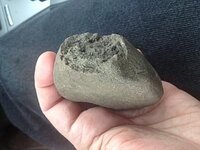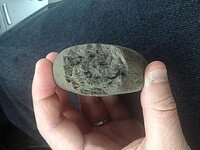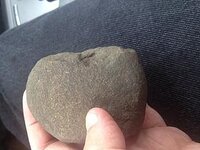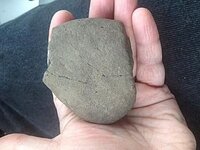I've noticed several threads here where rocks are mistaken for artifacts, maybe I can shed a bit of light here. There's a difference between a rock used once to bash in a tent stake (or too often my thumb!)  then tossed away & a shaped hammer. My full-blood grandfather who lived in a remote house in the mountains w/out electricity or running water until he was past 60, survived the Great Depression & insisted I learn 'the old ways' in case the world ever got stupid again. He also pointed out if you were alone in the mountains you had to make what you couldn't or didn't carry. I learned to make arrowheads, axes, spears, knives, arrows, bows, etc.. I learned to chop a tree w/ a stone ax I'd made... & really came to appreciate steel! It takes a LOT of work to make a good tool, even if you start out w/ a rock that's close to the right shape naturally. The easiest way is find a rock similar to what you need & work it rather than try to bash one out of a boulder. Eastern cultures w/ their softer rock tended to grind them into shape where westerners flaked them from obsidian, quartz, etc..
then tossed away & a shaped hammer. My full-blood grandfather who lived in a remote house in the mountains w/out electricity or running water until he was past 60, survived the Great Depression & insisted I learn 'the old ways' in case the world ever got stupid again. He also pointed out if you were alone in the mountains you had to make what you couldn't or didn't carry. I learned to make arrowheads, axes, spears, knives, arrows, bows, etc.. I learned to chop a tree w/ a stone ax I'd made... & really came to appreciate steel! It takes a LOT of work to make a good tool, even if you start out w/ a rock that's close to the right shape naturally. The easiest way is find a rock similar to what you need & work it rather than try to bash one out of a boulder. Eastern cultures w/ their softer rock tended to grind them into shape where westerners flaked them from obsidian, quartz, etc..
A lot of ax, arrowhead, hammer, etc. shaped rocks are found in ancient campsites that aren't real man-made tools but are there because someone picked it up thinking they could make it into one someday when they needed one... then a few hundred years later are picked up by someone looking for such & mistakenly thought to be man-made tools, Grandpa had such a pile behind his shop to use teaching us kids since you don't just suddenly find the perfect stone the moment you need it. Just because a rock is the right general shape & might have been touched by a Native American doesn't make it an artifact, sorry.
Hope this helps.
 then tossed away & a shaped hammer. My full-blood grandfather who lived in a remote house in the mountains w/out electricity or running water until he was past 60, survived the Great Depression & insisted I learn 'the old ways' in case the world ever got stupid again. He also pointed out if you were alone in the mountains you had to make what you couldn't or didn't carry. I learned to make arrowheads, axes, spears, knives, arrows, bows, etc.. I learned to chop a tree w/ a stone ax I'd made... & really came to appreciate steel! It takes a LOT of work to make a good tool, even if you start out w/ a rock that's close to the right shape naturally. The easiest way is find a rock similar to what you need & work it rather than try to bash one out of a boulder. Eastern cultures w/ their softer rock tended to grind them into shape where westerners flaked them from obsidian, quartz, etc..
then tossed away & a shaped hammer. My full-blood grandfather who lived in a remote house in the mountains w/out electricity or running water until he was past 60, survived the Great Depression & insisted I learn 'the old ways' in case the world ever got stupid again. He also pointed out if you were alone in the mountains you had to make what you couldn't or didn't carry. I learned to make arrowheads, axes, spears, knives, arrows, bows, etc.. I learned to chop a tree w/ a stone ax I'd made... & really came to appreciate steel! It takes a LOT of work to make a good tool, even if you start out w/ a rock that's close to the right shape naturally. The easiest way is find a rock similar to what you need & work it rather than try to bash one out of a boulder. Eastern cultures w/ their softer rock tended to grind them into shape where westerners flaked them from obsidian, quartz, etc.. A lot of ax, arrowhead, hammer, etc. shaped rocks are found in ancient campsites that aren't real man-made tools but are there because someone picked it up thinking they could make it into one someday when they needed one... then a few hundred years later are picked up by someone looking for such & mistakenly thought to be man-made tools, Grandpa had such a pile behind his shop to use teaching us kids since you don't just suddenly find the perfect stone the moment you need it. Just because a rock is the right general shape & might have been touched by a Native American doesn't make it an artifact, sorry.
Hope this helps.
Upvote
0







 Sometimes when a hot rock is dropped into cold water it shatters like that. It's also possible someone started working on grinding it into a mano (grinding stone) or pottery polishing tool but never finished & was chipped later. It's also possible it's just a rock polished & chipped by nature. It's an interesting rock but since it's not a fine, finished piece has no value as an artifact. Some of the more crude tribes didn't finish their tools well & things found in their camp are worthless even though used by them.
Sometimes when a hot rock is dropped into cold water it shatters like that. It's also possible someone started working on grinding it into a mano (grinding stone) or pottery polishing tool but never finished & was chipped later. It's also possible it's just a rock polished & chipped by nature. It's an interesting rock but since it's not a fine, finished piece has no value as an artifact. Some of the more crude tribes didn't finish their tools well & things found in their camp are worthless even though used by them.



